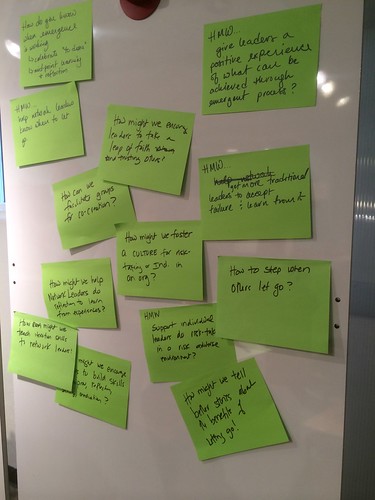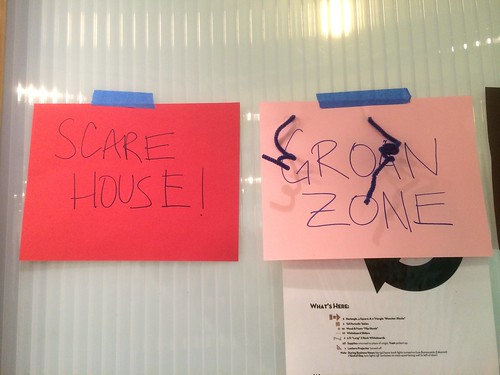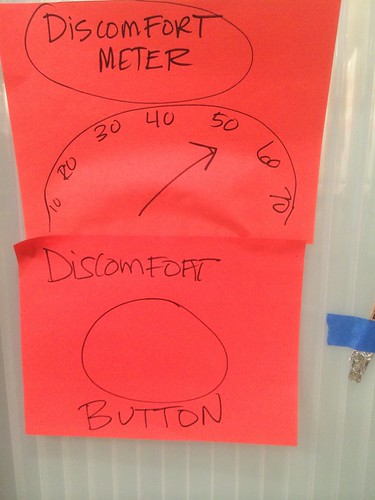
Last month, I participated in a Design Thinking Lab with network leadership practitioners convened by the Leadership Learning Community. The lab was facilitated by Heather Mcleod-Grant and Justin Ferrell, Director of Fellowships at the Stanford d-School. The session was an introduction to design thinking methods and to generate ideas for instructional modules for networked leadership development. The design challenge was: How do we come up with concrete tools, frameworks and methods for helping people better understand and adopt network systems leadership?
Like all good training sessions, this workshop started off with an opening conversation that allowed us to get to know others in the room and connect to what we already know. Heather facilitated this exercise as a series of share pairs where we discussed each question with a different partner for a few minutes. The questions:
- What do you hope to learn today?
- What’s the biggest challenge related to networks and leadership?
- Your biggest insight about network leadership?
- Your hopes for today: brilliant success?
After finishing the share pairs, we did a quick full group “popcorn” of the ideas that bubbled up. As a participant, it was fantastic to chat with other people about these questions. The big themes that emerged included:
- How do we get people to value both the journey as well as the goal?
- How do we help individuals and organizations make that internal shift in mindset as well as structure for working to be effective?
- How do we get a telling the story about why this all important?
- How do let go and allow for emergence?
For the rest of the morning, we learned about design thinking by doing it through “A Crash Course in Design Thinking.” The session starts with two quick exercises so we can be comfortable with the concepts. The first was for us to draw portrait in 30 seconds of our partner and then debrief on how it felt. It is always surprising how many of us feel discomfort when asked to draw. The point is that you don’t have to be Picasso or draw well to be a designer.
For the second short exercise, we were asked to jump into solving the design challenge, in this case, design the perfect wallet. That is a typical problem-solving approach, taking on a given problem, working using your own opinions and experience to guide you, and with a solution in mind to be designed. That is not design thinking.
The session lead us through the design thinking process which includes: empathize, define, ideate, prototype, and test. This allowed us to experience the whole design process – design a new wallet – and reflect on it. This set us up for the afternoon session that focused on applying design thinking to the task of coming up with some concrete tools or frameworks for networked leadership. We were assigned to small groups to work a specific theme. I got to work in a small group that was tackling the question “Letting Go and Emergence.”
For the empathy and shared understanding steps, we listened to a case study and research on network leadership and best practices from Deborah Meehan. Working in our small groups, we each discussed what we already know about the topic, what worked and what some of the challenges were. We were then each asked to tell a story related to the theme using a “mad libs” structure.
1. Once upon a time x happened
2. Next thing we know, this happened
3. It was followed by this:
4. Until one day, x happened:
5. Because x happened, we learned that:
Next, based on our discussion and storytelling, we shifted in the ideation stage and brainstormed questions on sticky notes beginning with “How might we ..” The goal was to generate, not judge our ideas.

Next, we looked for patterns and grouped together the sticky notes into clusters. The following emerged for our group:

How do we support individual leaders in risk taking that leads to emergence?

How do we teach leaders to know when emergence is working?
We voted on what thought might be the most productive to prototype and test related to “letting go and allowing for emergence.” We circled in on these ideas:
- Revisiting the discomfort zone and know it is normal
- Understanding the groan zone
- Normalize the hump
In the definition process, we talked about networks take time to develop and often times we feel like it is a failure in the middle. We all love energizing beginnings and happy endings, but it is the middle of a process of change that involves hard work.
Another way to describe this middle or hump, is “groan zone.” Which comes from the Participatory Facilitator’s Guide. It refers to the part of a participatory process where you know the problem or consensus won’t come easily. You might want to groan, but you need to keep on going.
How do you get past that fear of letting go or fear of something not being perfect? Wallow in it. That comes from Rosabeth Moss Kanter (no relation): “A counter-intuitive tip for mastering change is to start by wallowing in the feelings of dread it arouses. The sheer nail-biting horror of it all. Get in touch with every negative aspect, all the things that could go wrong. Then figure out a way to get that negative force on your side. In short, dream your worst nightmare and invest in it.

Our prototype idea was “The Groan Zone Scare House.” It would be a video, instructional role play, or case study, where a network leader would share their story of events leading up to the groan zone and getting past it. Participants would have clickers and would be instructed to click every time they felt some discomfort. The score of the all participants would be visible on a discomfort meter. Once the story was told, there would be a discussion about when they felt the most discomfort, when they would give up, and come up with ideas about getting past the groan zone.

We had to also test the prototype by acting it out with another small group and get their feedback. This is always enlightening. And, then we gave a brief presentation to the full group after incorporating the feedback. Essentially, design thinking process teaches how to be iterative.

All in all it was a fantastic day of learning. Colleague, June Holley, was not able to participate in person, but was able to participate via skype.
Have you used design thinking in your nonprofit’s work? What was your experience? Did it lead to better problem-solving and a productive feedback loop?
